The factory races towards the digital future
Mitsubishi Electric is oriented towards the future and follows the e-F@ctory concept, where the factory is collaborative and has a strong digitization. The company’s vision is based on three fundamental pillars, intelligence, integration and safety, which are well summarised by the MELFA Assista cobot, which has industrial characteristics but at the same time can cooperate side by side with human operators.
The digitisation of the company dimension and concepts linked to Lean Manufacturing currently represent the elements which best characterise the national and international industrial structure. The future of the industry undoubtedly depends on enabling technologies and a digital transformation process focused on achieving clear and well-defined objectives. In this respect, Mitsubishi Electric represents a pioneer on the market: the collaborative factory, represented by the e-F@ctory concept, was introduced in Japan as early as 2001, and the solutions developed were first tested and implemented in its own factories. The objectives of the digital transition may be identified in four macro areas, which aim to improve line productivity, reduce costs associated with production, increase quality standards and reduce lead times. The achievement of these objectives is inextricably linked to the analysis of big data and new trends in artificial intelligence, effective tools for optimising value chains and enabling ‘intelligent’ functions at factory level and beyond.
Within the shopfloor dimension, robots are no longer considered as single elements along the production line but as integrated and connected parts of the production dimension, where machines, robotic cells and sensors share data globally to ensure maximum transparency and efficiency.
The collection and analysis of these data makes it possible to implement predictive maintenance functions, which, given a process pattern, foresee abnormal robot behaviour and eliminate potential downtime, thus reducing the Total Cost of Ownership. The new 5.0 company structure will thus be characterised by production flexibility, horizontal and vertical integration between the various company levels, and by increasing attention to human-machine interaction in terms of safety and ergonomics.

The three conceptual pillars
Mitsubishi Electric’s vision is oriented towards the future of industry and is based on three conceptual pillars: intelligence, integration and safety.
The concept of intelligence is translated into the MAISART brand (Mitsubishi Electric’s AI creates the State-of-the-ART in technology), which includes the latest developments of research on Machine Learning and Deep Learning. Therefore, thanks to statistical tools and Artificial Intelligence algorithms, it is possible to increase the performance of the robot, reduce set-up times and eliminate potential “down time”, developing systems displaying greater adaptability and autonomy. Robot Motion Planning provides the best interpretation of the concept of autonomy and represents a robot solution capable of calculating and determining in real time the optimal path to reach the desired position, avoiding any obstacle along the way and guaranteeing the complete safety of the operator. In terms of integration, Mitsubishi Electric offers matrix interconnection solutions which allow information to be managed horizontally, thanks to the iQ-R automation platform, and to develop the data flow vertically towards IT systems, enabling levels of Edge and Cloud Computing. Finally, in terms of safety, Mitsubishi Electric offers a complete collaborative approach, structured according to levels of operator-robot interaction defined on a time basis. This begins with the first level represented by industrial robotics and ends with the latest frontier of collaboration: the new MELFA Assista collaborative robot.

A cobot with a repeatability of ±0.03 mm
MELFA ASSISTA bases its concept of collaboration on three main features leading to simplicity of control, ease of programming and connection to optional tools. Mitsubishi Electric’s new cobot has been developed to work alongside operators in total safety, without the need for barriers or external safety sensors, and features an ergonomic design with industrial features and TÜV certification to meet collaboration standards and new requirements regarding social distancing in production sites. MELFA ASSISTA ensures full compatibility with ISO standards and, thanks to the MELFA Safe Plus module, is able to handle advanced safety functions with a simple setting change. This configuration allows the robot to go up to a maximum speed of 1 m/s and enables the management of safety volumes and internal logic, ensuring maximum flexibility right from the 3D simulation phase.
Thanks to the rigidity of the arm and the new next-generation MR-J5 servomotors combined with harmonic gearboxes, MELFA ASSISTA has a repeatability of only ±0.03 mm with a nominal payload of 5 kg and a reach of 910 mm; these typically industrial features improve the robot’s performance and guarantee more stringent quality controls.

